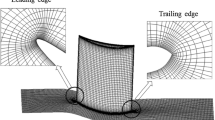Abstract
Experimental investigation was carried out to study the effect of suction positions and suction flow rates on the aerodynamic performance of a compressor cascade with a large camber angle. The ink-trace flow visualization was conducted and the flow fields of the cascade were also measured. Three types of boundary layer suction configurations are compared, i.e. the suction surface suction, the endwall suction and the compound suction. Experimental results show that the large amount of suction flow rate gains more losses reduction than the small amount for a certain proper suction configuration, but the speed of loss decline slows down as the suction flow rate goes on increasing. Boundary layer suction on the suction surface obviously enhances the ability of the boundary layer around the midspan to withstand the negative pressure gradient of the flow passage. The range of the suction surface corner is also decreased. If the suction slot locates in the corner separation region where severe separation has happened, the flow separation will be terminated at the slot and redevelop downstream. And boundary layer suction on the endwall mainly influences the endwall corner region in remarkably delaying, lessening and reorganizing the corner separation. While the whole flow field is remarkably improved at both midspan and the corner region in the compound suction schemes. At higher suction flow rates, the aerodynamic performance of the compressor cascade is better than that with boundary layer suction simply on the suction surface or on the endwall. When the suction flow rate is 1.5% of the inlet mass flow, the compound suction scheme achieves a maximum loss reduction of 17% compared with the cascade without boundary layer suction.
Similar content being viewed by others
Abbreviations
- B :
-
axial blade chord
- b :
-
blade chord
- d :
-
distance between endwall slots and blades
- h :
-
blade height
- i :
-
incidence
- P :
-
pressure
- Re :
-
Reynolds number
- t :
-
blade pitch
- U :
-
inlet velocity
- w :
-
suction slot width
- SS:
-
schemes with suction slot on the suction surface
- EW:
-
schemes with suction slot on the endwall
- α 1P :
-
inlet metal angle
- α 2P :
-
outlet metal angle
- β :
-
suction flow rate relative to inlet mass flow
- β t :
-
stagger angle
- θ :
-
blade camber
- ρ :
-
density
- σ :
-
chord to pitch ratio, solidity
- ω :
-
total pressure coefficient
- 0:
-
stagnation
- 1:
-
inlet
- 2:
-
outlet
- t:
-
total
- m:
-
overall mass-averaged
- —:
-
relative value
References
Wennerstrom A J. Highly loaded axial flow compressor history and current development. J Turbomach, 1990, 112: 567–578
Loughery R, Horn R A. Single stage experimental evaluation of boundary layer blowing and bleed techniques for high lift stator blades. NASA, CR-54573, 1971
Kerrebrock J L, Reijnan D P, Ziminsky W S, et al. Aspirated compressors. ASME Paper, 97-GT-525, Orlando, 1997
Kerrebrock J L, Drela M A, Merchant A, et al. A family of designs for aspirated compressors. ASME Paper, 1998, 98-GT-196
Reijnen D P. Experimental study of boundary layer suction in a transonic compressor. PhD Thesis. Cambridge, MA: MIT, January, 1997
Schuler B J, Kerrebrock J L, Merchant A A, et al. Design, analysis, fabrication and test of an aspirated fan stage. ASME Paper, 2000, 2000-GT-618
Merchant A A, Drela M, Kerrebrock J L, et al. Aerodynamic design and analysis of a high pressure ratio aspirated compressor stage. ASME Paper, 2000, 2000-GT-619
Merchant A, Kerrebrock J L, Adamczyk J J, et al. Experimental investigation of a high pressure ratio aspirated fan stage. ASME Paper, 2004, GT2004-53679
Song Y, Chen F, Jun Y, et al. A numerical investigation of boundary layer suction in compound lean compressor cascades. ASME Paper, 2005, GT2005-68441
Chen F, Song Y, Chen H, et al. Effects of boundary layer suction on the performance of compressor cascades. ASME Paper, 2006, GT2006-90082
Semiu A G, Nicholas A C, Tom P H. Control of three-dimensional separations in axial compressors by tailored boundary layer suction. J Turbomach, 2008, 130 (1): 011004-1–011004-8
Tan C, Zhang H, Chen H, et al. Flow separation control by using bowed blade in highly loaded turbine cascades. Sci China Ser E-Tech Sci, 2009, 52(6): 1471–1477
Author information
Authors and Affiliations
Corresponding author
Rights and permissions
About this article
Cite this article
Guo, S., Chen, S., Lu, H. et al. Enhancing aerodynamic performances of a high-turning compressor cascade via boundary layer suction. Sci. China Technol. Sci. 53, 2748–2755 (2010). https://doi.org/10.1007/s11431-010-4069-2
Received:
Accepted:
Published:
Issue Date:
DOI: https://doi.org/10.1007/s11431-010-4069-2




